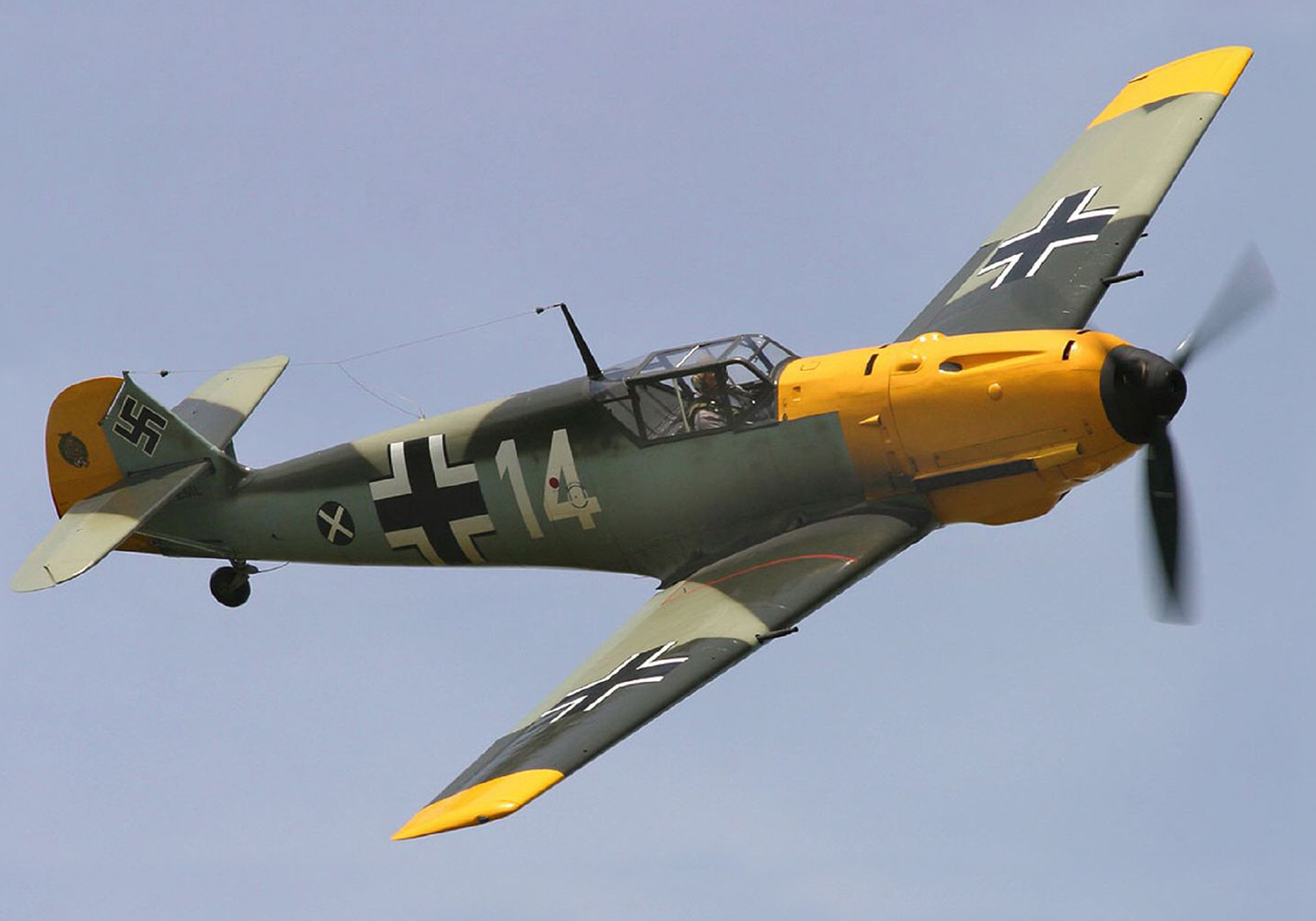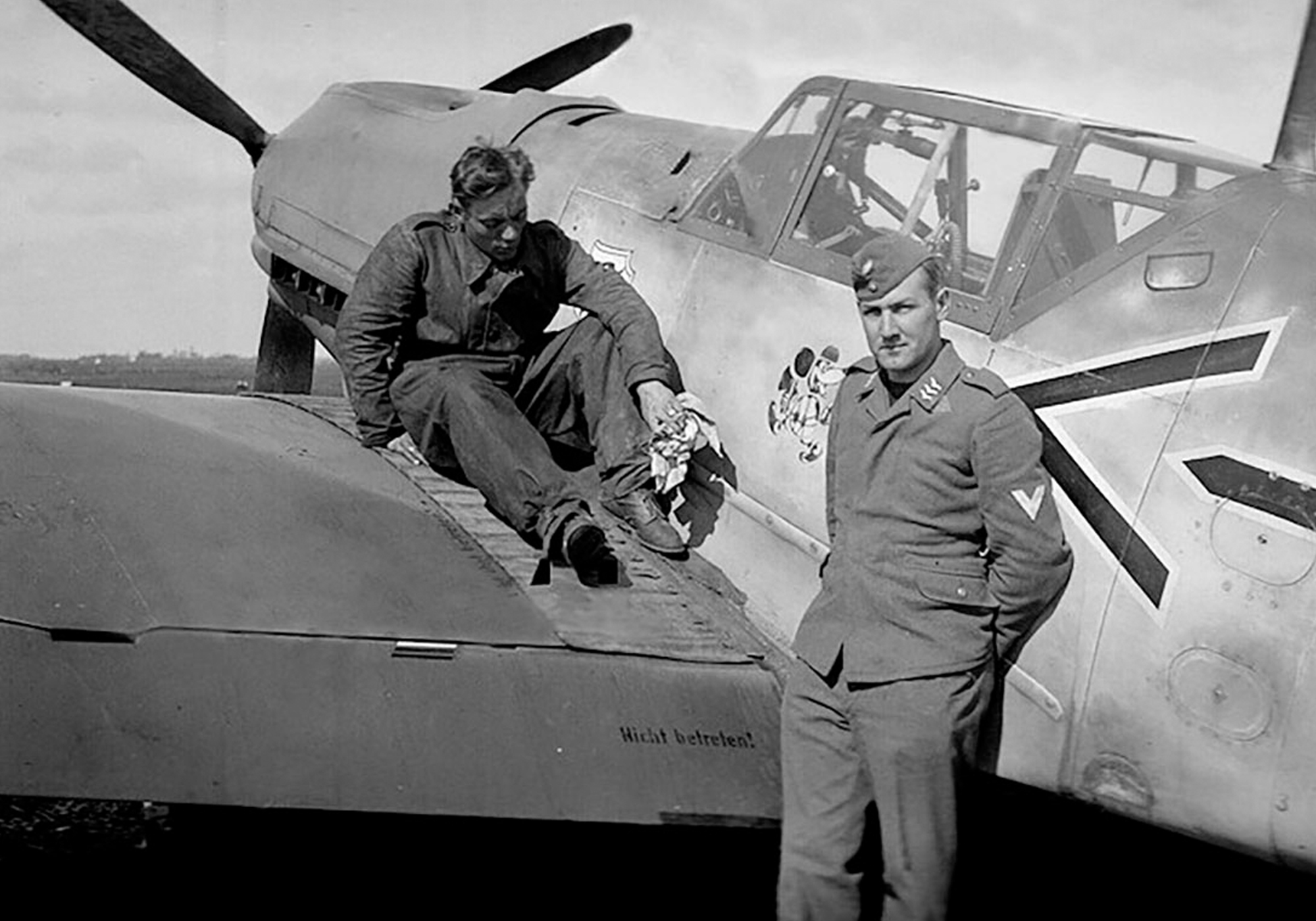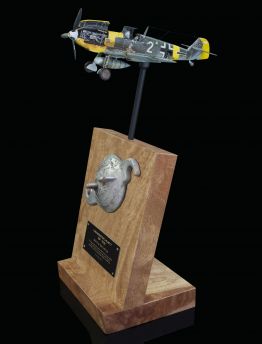- AUST POST SHIPPING
- 0438 654 235
- info@recoverycurios.com
- P.O. Box 7640 Cairns QLD Australia, 4870
-
0
Shopping Cart


MESSERSCHMITT BF-109
 Designed by Willy Messerschmitt and Robert Lusser, the Messerschmitt Bf 109 was the Luftwaffe's primary single-engine fighter first seeing operational service in 1937 during the Spanish Civil War with later models serving as bomber escort, fighter-bomber, ground-attack aircraft, and as reconnaissance aircraft.
Designed by Willy Messerschmitt and Robert Lusser, the Messerschmitt Bf 109 was the Luftwaffe's primary single-engine fighter first seeing operational service in 1937 during the Spanish Civil War with later models serving as bomber escort, fighter-bomber, ground-attack aircraft, and as reconnaissance aircraft.
 The Bf-109’s liquid-cooled, inverted-V12 aero engine, made it one of the most advanced fighters of the era featuring an all-metal monocoque construction, a closed canopy, and retractable landing gear. The Bf 109 was the most produced fighter aircraft in history, with a total of 33,984 airframes produced from 1936 up to April 1945.
The Bf-109’s liquid-cooled, inverted-V12 aero engine, made it one of the most advanced fighters of the era featuring an all-metal monocoque construction, a closed canopy, and retractable landing gear. The Bf 109 was the most produced fighter aircraft in history, with a total of 33,984 airframes produced from 1936 up to April 1945.
 With an eye to quick, on-going servicing and easy maintenance, Willy Messerschmitt employed his "lightweight construction" principle, which aimed to minimise the number of separate parts in the aircraft with priority given to easy access to the power-plant, fuselage weapons and other systems while the aircraft was operating from forward airfields.
With an eye to quick, on-going servicing and easy maintenance, Willy Messerschmitt employed his "lightweight construction" principle, which aimed to minimise the number of separate parts in the aircraft with priority given to easy access to the power-plant, fuselage weapons and other systems while the aircraft was operating from forward airfields.
To ensure quick access to its power-plant, the entire engine cowling was made up of large, easily removable panels which were secured by large toggle latches. A large panel under the wing centre section could be removed to gain access to the L-shaped main fuel tank, while other smaller panels gave easy access to the cooling system and electrical equipment.
 The engine was held in two large, forged, Elektron magnesium alloy Y-shaped legs, one per side straddling the engine block, which were cantilevered from the firewall. Each of the legs was secured by two quick-release screw fittings on the firewall. All of the main pipe connections were colour-coded and grouped in one place, where possible, and electrical equipment plugged into junction boxes mounted on the firewall. The entire power-plant could be removed or replaced as a unit in a matter of minutes.
The engine was held in two large, forged, Elektron magnesium alloy Y-shaped legs, one per side straddling the engine block, which were cantilevered from the firewall. Each of the legs was secured by two quick-release screw fittings on the firewall. All of the main pipe connections were colour-coded and grouped in one place, where possible, and electrical equipment plugged into junction boxes mounted on the firewall. The entire power-plant could be removed or replaced as a unit in a matter of minutes.
 Reflecting Messerschmitt's belief in low-weight, low-drag, simple monoplanes, the armament was placed in the fuselage. This kept the wings very thin and light. Two synchronised machine guns were mounted in the cowling, firing over the top of the engine and through the propeller arc.
Reflecting Messerschmitt's belief in low-weight, low-drag, simple monoplanes, the armament was placed in the fuselage. This kept the wings very thin and light. Two synchronised machine guns were mounted in the cowling, firing over the top of the engine and through the propeller arc.
While Luftwaffe pilots initially disliked its steep ground angle, which resulted in poor forward visibility when taxiing and its sideways-hinged cockpit canopy, which could not be opened in flight, they were soon won over.
The Bf-109 was fast, agile  and had an outstanding rate of climb which proved to be far superior to its later Allied adversaries including the Supermarine Spitfire, P51D Mustang and Hawker Tempest.
and had an outstanding rate of climb which proved to be far superior to its later Allied adversaries including the Supermarine Spitfire, P51D Mustang and Hawker Tempest.
The Bf 109 was flown by the three of Germany’s top-scoring fighter aces of World War II, who claimed 928 victories among them while flying with Jagdgeschwader 52, mainly on the  Eastern Front. The highest scoring fighter ace of all time, Erich Hartmann, flew the Bf 109 and was credited with 352 aerial victories. The aircraft was also flown by Hans-Joachim Marseille, the highest scoring German ace in the North African Campaign who achieved 158 aerial victories.
Eastern Front. The highest scoring fighter ace of all time, Erich Hartmann, flew the Bf 109 and was credited with 352 aerial victories. The aircraft was also flown by Hans-Joachim Marseille, the highest scoring German ace in the North African Campaign who achieved 158 aerial victories.
When it was discovered in 1937 that the RAF was planning eight-gun batteries for its new Hawker Hurricane and Supermarine Spitfire fighters, it was decided that the Bf 109 should be more heavily armed and a 7.92 mm MG 17 machine gun, or a 20 mm MG FF or MG FF/M cannon were added to each wing which required the creation of an unusual ammunition feed with a continuous belt holding 500 rounds was fed along chutes out to the wing tip, around a roller and then back along  the wing, forward and beneath the gun breech, to the wing root, where it coursed around another roller and back to the weapon.
the wing, forward and beneath the gun breech, to the wing root, where it coursed around another roller and back to the weapon.
Additional firepower was also provided through a pair of 20 mm MG 151/20 cannons installed in streamlined gun pods under the wings and whilst the additional armament increased the fighter's potency as a bomber destroyer, it had an adverse effect on the handling qualities, reducing its competitiveness in fighter-versus-fighter combat.
In all, it was a robust, fast and deadly adversary and during the Battle of Britain could have significantly changed the conflict’s outcome had it not been hampered by its lack of range as a bomber escort over Britain, which resulted in much of the bomber force left unprotected over their targets as the Bf-109 was forced to turn for home due to lack of fuel.
All Messerschmitt BF-109 Instruments listed below come complete with detailed Scale Model, Mango Wood Stand & Plaque plus Printed Fact Sheet featuring photo of instrument in aircraft cockpit.
Return to VINTAGE ORIGINAL AIRCRAFT INSTRUMENTS
- LAND
- SEA
- AIR
- VINTAGE ORIGINAL AIRCRAFT INSTRUMENTS
- HAWKER TYPHOON
- VICKERS WELLINGTON
- FAIREY GANNET
- RYAN ST-A SPORTS TRAINER
- DE HAVILLAND TIGER MOTH
- HAWKER HUNTER
- Mc DONNELL DOUGLAS KC-10 AERIAL TANKER
- SOPWITH CAMEL
- AIRCO DH.1 AND DH.2
- JUNKERS JU 87
- CURTISS C-46 COMMANDO
- HANDLEY PAGE HAMPDEN
- SUPERMARINE SEAFIRE
- B-25 MITCHELL BOMBER
- BRISTOL BLENHEIM
- ENGLISH ELECTRIC LIGHTNING
- HAWKER TEMPEST MkVI
- YAKOVELOV YAK - 3
- FOCKE-WULF FW190
- FOLLAND GNAT
- AIRSPEED OXFORD
- SHORT STIRLING
- AVRO ANSON
- DOUGLAS C-133 CARGOMASTER
- HANDLEY PAGE VICTOR BOMBER
- DE HAVILLAND SEA VENOM
- VICKERS VALIANT BOMBER
- DOUGLAS A-26 INVADER
- GRUMMAN S2F TRACKER
- SUPERMARINE SPITFIRE
- LOCKHEED P2-V NEPTUNE
- P-51 MUSTANG
- BRISTOL BEAUFIGHTER
- DE HAVILLAND MOSQUITO
- B-26 MARTIN MARAUDER
- P3 ORION
- DOUGLAS A-20 HAVOC
- P-39 AIRACOBRA
- AVRO SHACKLETON
- B-17 FLYING FORTRESS
- B-24 LIBERATOR
- MESSERSCHMITT BF-110
- MESSERSCHMITT BF-109
- BRISTOL BEAUFORT
- KAWASAKI Ki-45 (NICK) INTERCEPTOR
- C-130 HERCULES
- CAC BOOMERANG
- AVRO LANCASTER
- GRUMMAN F4F WILDCAT
- F4U VOUGHT CORSAIR
- WESTLAND LYSANDER
- P-47 REPUBLIC THUNDERBOLT
- NORTH AMERICAN T-6 TEXAN - HAVARD
- C-47 SKYTRAIN
- DOUGLAS SBD DAUNTLESS
- CAC WIRRAWAY
- PBY CATALINA
- P-40 WARHAWK
- FAIREY SWORDFISH
- P-38 LIGHTNING
- HAWKER HURRICANE
- CURTISS SB2C HELLDIVER
- GRUMMAN F6F HELLCAT
- SEAKING HELICOPTER
- SEAHAWK HELICOPTER
- DOUGLAS A4G SKYHAWK
- GRUMMAN TBF AVENGER
- HANDLEY PAGE HALIFAX
- DOUGLAS SKYRAIDER AE-1
- GLOSTER METEOR
- JUNKERS JU-88
- F-86 SABRE JET
- SHORT SUNDERLAND
- B-29 SUPER FORTRESS
- F-9F GRUMMAN PANTHER
- F-100D SUPER SABRE
- BELL UH-1 HUEY HELICOPTER
- AVRO VULCAN STRATEGIC BOMBER
- CANBERRA BOMBER
- DHC-4 CARIBOU
- BLACKBURN BUCCANEER
- DE HAVILLAND VAMPIRE JET
- HAWKER SEA FURY
- LOCKHEED HUDSON
- LOCKHEED EC-121 WARNING STAR
- SEPECAT JAGUAR
- HAWKER SIDDELEY NIMROD
- HAWKER SIDDELEY HARRIER
- ARADO AR 196
- VOUGHT OS2U KINGFISHER
- LOCKHEED ELECTRA
- NORTHROP P-61 BLACK WIDOW
- BOEING CH-47 CHINOOK
- LOCKHEED PV-1 VENTURA
- BOEING P26-A 'PEASHOOTER'
- Ilyushin Il-2 ‘Sturmovik’
- WESTLAND WESSEX
- FAIREY FIREFLY
- VINTAGE AVIATION COLLECTABLES
- VINTAGE COLLECTABLE MODEL AIRCRAFT KITS
- RETRO STYLE METAL AIRCRAFT COLLECTABLES
- VINTAGE ORIGINAL AIRCRAFT INSTRUMENTS






